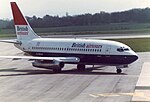History of Manchester Airport

The origins of Manchester Airport in England, UK, date back to the 1930s. Construction started on Ringway on 28 November 1935 and it opened partly in June 1937 and completely on 25 June 1938, in Ringway parish north of Wilmslow, from which it derived its original name Manchester (Ringway) Airport. Its north border was Yewtree Lane. Its southeast border was a little northwest of Altrincham Road (Styal). Local roads relevant to this account, on the map below: Yewtree Lane: the lane from the junction by Firtree Farm west to The Grange (east of the crossroads marked "Ringway"), and continuing northwest past Manor Farm to the next junction. Altrincham Road (Styal): the lane from Oversleyford running northeast then east into the Styal area.In World War II, it was the location of RAF Ringway, and was important in the production and repair of military aircraft and training parachutists. After World War II, it gradually expanded to its present size, including massive expansion of aprons, runways and car parking areas. Among the first expansions was car parking and service buildings north of Yewtree Lane. From 1958 to late 1962, Terminal 1 was built: this was the first of Ringway's modern large terminals and the first major public building north of Yewtree Lane. In 1997, the second runway was planned and construction on it started, with protests about it intruding on woodland in the Styal area.
Excerpt from the Wikipedia article History of Manchester Airport (License: CC BY-SA 3.0, Authors, Images).History of Manchester Airport
T1 - T3 walkway, Manchester Ringway
Geographical coordinates (GPS) Address Nearby Places Show on map
Geographical coordinates (GPS)
| Latitude | Longitude |
|---|---|
| N 53.353888888889 ° | E -2.275 ° |
Address
T1 - T3 walkway
M90 1QD Manchester, Ringway
England, United Kingdom
Open on Google Maps




